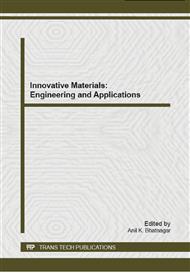[1]
X.G. Zhou, Y. You, C.R. Zhang, B.Y. Huang, X.Y. Liu, Effect of carbon fiber pre-heat treatment on the microstructure and properties of Cf/SiC composites, Mater. Sci. Eng. A 433(2006)104–107.
Google Scholar
[2]
R. Dong, Y. Hirata, H. Sueyoshi, M. Higo, Y. Uemura, Polymer impregnation and pyrolysis (PIP) method for the preparation of laminated woven fabric/mullite matrix composites with pseudoductility, J. Eur. Ceram. Soc. 24(2004)53-64.
DOI: 10.1016/s0955-2219(03)00127-4
Google Scholar
[3]
R.M. Rocha, C.A.A. Cairo, M.L.A. Graca, Formation of carbon fiber reinforced ceramic matrix composites with polysiloxane/silicon derived matrix, Mater. Sci. Eng. A: Struct. Mater. Prop. Microstruct. Process. 437(2) (2006)268-273.
DOI: 10.1016/j.msea.2006.08.102
Google Scholar
[4]
H.F. Hu, Q.K. Wang, Z.H. Chen, C.R. Zhang, Y.D. Zhang, J. Wang, Microstructure observation and analysis of 3D carbon fiber reinforced SiC-based composites fabricated through filler enhanced polymer infiltration and pyrolysis, Ceram. Intern. 38 (2012).
DOI: 10.1016/j.ceramint.2011.07.039
Google Scholar
[5]
D.H. Ding, W.C. Zhou, F. Luo, M.L. Chen, D.M. Zhu, Mechanical properties and oxidation resistance of SiCf/CVI-SiC composites with PIP-SiC interphase, Ceram. Intern. 38(2012)3929-3934.
DOI: 10.1016/j.ceramint.2012.01.045
Google Scholar
[6]
R. Naslain, F. Langlais, G. Vignoles, R. Pailler, The CVI-process: state of the art and perspective, Ceram. Eng. Sci. Proc. 27(2006)373-86.
DOI: 10.1002/9780470291313.ch37
Google Scholar
[7]
X. Yang, Z. Su, Q.Z. Huang, X. Fang, L.Y. Chai, Microstructure and Mechanical Properties of C/C–ZrC–SiC Composites Fabricated by Reactive Melt Infiltration with Zr, Si Mixed Powders, J. Mater. Sci. Tech. 29(2013)702-710.
DOI: 10.1016/j.jmst.2013.05.005
Google Scholar
[8]
Y.G. Wang, X.J. Zhu, L.T. Zhang, L.F. Cheng, C/C–SiC–ZrC composites fabricated by reactive melt infiltration with Si0. 87Zr0. 13 alloy, Ceram. Intern. 38(2012)4337-4343.
DOI: 10.1016/j.ceramint.2012.02.016
Google Scholar
[9]
X. Yang, H.F. Hu, Y.D. Zhang, Z.H. Chen, Thermal shock properties of 3D-C/SiC composites prepared via polymer infiltration pyrolysis (PIP), Ceram. Intern. A40(2014)9087-9094.
DOI: 10.1016/j.ceramint.2014.01.122
Google Scholar
[10]
Z. Luo, X.G. Zhou, J.S. Yu, K. Sun, F. Wang, Mechanical properties of SiC/SiC composites fabricated by PIP process with a new precursor polymer, Ceram. Intern. B40(2014)1939-(1944).
DOI: 10.1016/j.ceramint.2013.07.102
Google Scholar
[11]
R. Jones, A. Szweda, D. Petrak, Polymer derived ceramic matrix composites, Composites: Part A 30(1995) 569-75.
DOI: 10.1016/s1359-835x(98)00151-1
Google Scholar
[12]
C.L. Yan, R.J. Liu, Y.B. Cao, C.R. Zhang, Fabrication and properties of PIP 3D Cf/ZrC–SiC composites, Mater. Sci. Eng. A 591(2014)105-110.
DOI: 10.1016/j.msea.2013.10.102
Google Scholar
[13]
Y.Z. Zhu, Z.R. Huang, S.M. Dong, M. Yuan, D.L. Jiang, The fabrication of 2D Cf/SiC composite by a modified PIP process using active Al powders as active filler, Mater. Characterization 59(2008)975-978.
DOI: 10.1016/j.matchar.2007.07.014
Google Scholar
[14]
M.A. Schiavon, I.V.P. Yoshida, J.C. Bressiani, W. Acchar, Ceramic composites derived from polysiloxane/Al/Nb by AFCOP process, Adv. Powder Technol. 498–499 (2005) 375–380.
DOI: 10.4028/www.scientific.net/msf.498-499.375
Google Scholar


